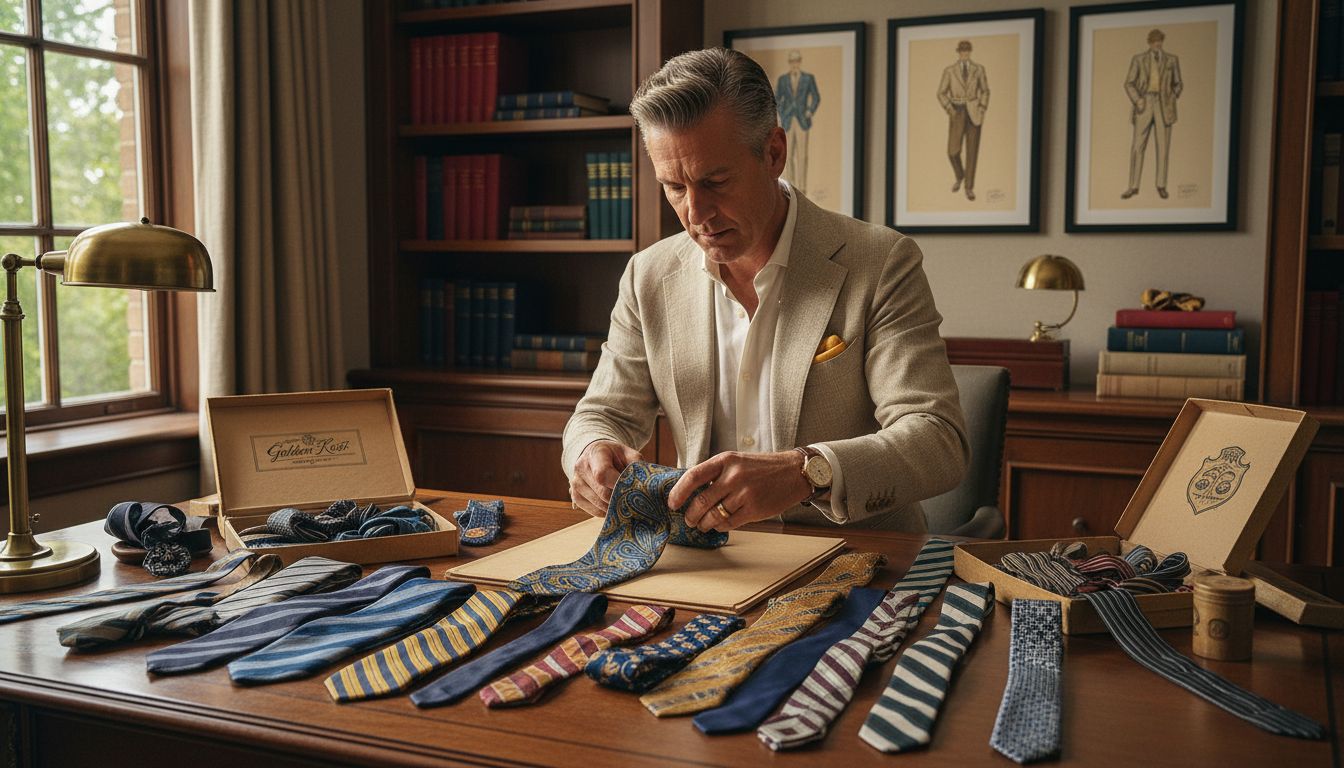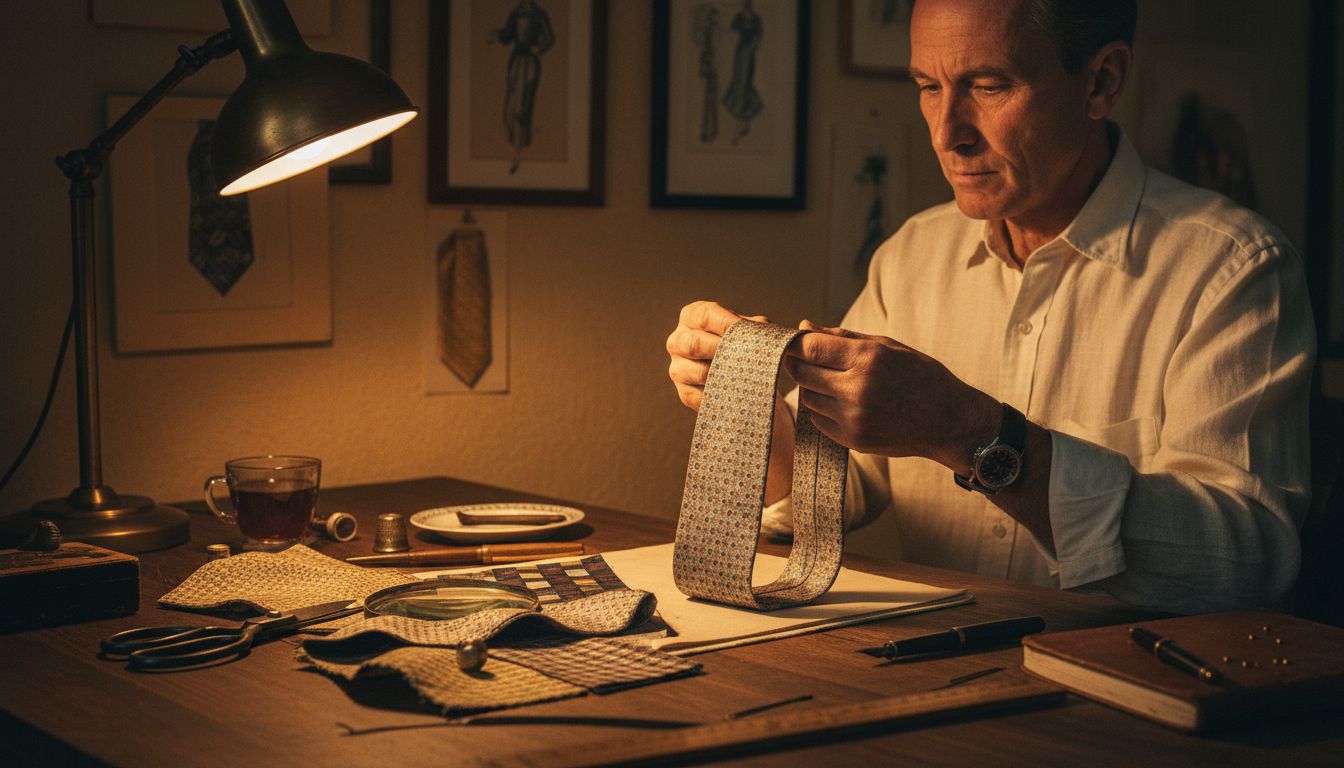Vintage Ties Explained: Styles, Tips, and Value
- Emma

- 11 hours ago
- 7 min read

More than 60 percent of modern fashion lovers are drawn to vintage pieces for their timeless appeal and character. Vintage ties stand out as unique collectors’ items, weaving history, craftsmanship, and personal style into a single accessory. Whether you are chasing originality or aiming to reduce waste with your wardrobe choices, these ties offer more than good looks. Discover how to spot authentic vintage ties, recognize key eras, and appreciate the subtle details that make these accessories so special.
Table of Contents
Key Takeaways
Defining Vintage Ties and Their Appeal
Vintage ties represent far more than mere fabric accessories - they are wearable time capsules that capture the unique aesthetic and cultural essence of different historical periods. According to research from University of Huddersfield, vintage fashion consumption reflects deeper societal shifts, including a growing desire for individual expression and sustainable fashion choices.
The appeal of vintage ties stems from their extraordinary ability to transcend simple fashion statements. They offer wearers a connection to historical craftsmanship, allowing individuals to curate a personal style that speaks volumes about their appreciation for design heritage. University of Leeds research highlights how vintage accessories like ties connect past and present, creating a nostalgic narrative that resonates with contemporary fashion enthusiasts.
Key characteristics that define vintage ties include:
Exceptional fabric quality rarely seen in modern mass-produced accessories
Unique patterns reflecting specific historical design movements
Handcrafted details demonstrating superior tailoring techniques
Rare materials like pure silk, wool, and intricate woven patterns
Beyond aesthetic value, vintage ties represent a sustainable fashion choice. By choosing pre-loved accessories, fashion-conscious individuals reduce textile waste and challenge the disposable nature of contemporary fashion cycles. Each vintage tie tells a story - a testament to enduring style and craftsmanship that transcends fleeting trends.
For those seeking to explore vintage menswear, understanding these unique accessories in context can transform how you perceive fashion history and personal style.
Recognising Vintage Tie Eras and Styles
Understanding vintage tie styles requires a deep dive into the fascinating evolution of men’s fashion across different decades. Wikipedia provides crucial insights into how necktie designs have dramatically transformed, reflecting the cultural and aesthetic shifts of each era.
The mid-20th century witnessed remarkable tie style transitions. From the Bold Look of the 1940s featuring wide, dramatic ties to the slimmer silhouettes of the 1950s and 1960s, each period had its distinctive characteristics. A prime example of this era’s bold fashion statement was the kipper tie. As Wikipedia notes, these ties were particularly prominent in Britain from the mid-1960s to late 1970s, characterised by their extraordinary breadth and audacious patterns.
Vintage tie eras can be broadly categorised as follows:
1940s: Wide, substantial ties reflecting post-war confidence
1950s: Slim, more streamlined designs emerging with modernist aesthetics
1960s: Experimental patterns and bold color combinations
1970s: Extremely wide ties with psychedelic and abstract prints
1980s: Power ties featuring strong, saturated colors
For enthusiasts looking to explore the broader context of vintage menswear, exploring the historical progression of men’s fashion can provide deeper understanding of how tie styles emerged and evolved. Each era’s ties are not just accessories, but historical artifacts that capture the design sensibilities and cultural zeitgeist of their time.
Identifying Fabrics and Construction Details
Discerning the quality of vintage ties requires a keen eye for fabric composition and intricate construction techniques. Wikipedia reveals that the evolution of necktie manufacturing has been marked by significant transformations in materials and craftsmanship, making each vintage piece a unique historical artifact.
At the pinnacle of tie craftsmanship are hand-sewn ties, exemplified by legendary makers like Charvet. As Wikipedia details, these exceptional ties are constructed using three pieces of silk meticulously cut at a precise 45-degree angle and sewn entirely by hand. This level of craftsmanship distinguishes true luxury vintage ties from mass-produced alternatives.
Key factors in identifying high-quality vintage tie fabrics include:
Silk Quality: Pure mulberry silk with a smooth, lustrous finish
Weave Complexity: Intricate jacquard or herringbone weaves
Hand-Rolling: Carefully rolled edges, a hallmark of superior construction
Bias Cut: Fabric cut diagonally to ensure better drape and durability
Interlining: High-quality wool or cotton interlining for structure
For vintage fashion enthusiasts seeking to deepen their understanding, learning to confidently identify vintage clothing details can transform your approach to collecting and appreciating these remarkable textile treasures. Each tie tells a story of craftsmanship, design, and the cultural moment of its creation.

Collecting, Storing, and Wearing Vintage Ties
Collecting vintage ties is more than a hobby - it’s a passionate exploration of fashion history and personal style. Research from the University of Huddersfield reveals that vintage fashion collectors are driven by a deep desire to preserve unique pieces that tell compelling stories about design and cultural evolution.
The emotional connection to vintage ties runs deep. As University of Leeds research highlights, these accessories are not merely fabric, but tangible links to past aesthetic moments. Collecting requires both an aesthetic eye and careful preservation strategies to maintain their integrity and value.
Essential tips for vintage tie enthusiasts include:
Careful Storage: Store ties flat or loosely rolled to prevent creasing
Climate Control: Keep in cool, dry spaces away from direct sunlight
Acid-Free Materials: Use archival tissue paper for wrapping
Rotation: Alternate tie usage to prevent excessive wear
Professional Cleaning: Seek specialists in vintage textile restoration
For those looking to expand their vintage accessory knowledge, exploring comprehensive guides to collecting vintage accessories can provide invaluable insights into building a meaningful collection. Remember, each vintage tie is a wearable piece of history waiting to be cherished and celebrated.
Buying Authentic Vintage Ties in the UK
Navigating the world of authentic vintage ties requires a discerning eye and deep understanding of historical fashion markers. Research from Nottingham Trent University highlights the complexities of vintage fashion commercialization, emphasizing the critical importance of authenticity in the UK market.
Authenticity goes beyond mere age - it’s about understanding the intricate details that define a genuine vintage piece. As the University of St Andrews research suggests, vintage clothing tells a story, with each tie representing a unique cultural moment frozen in textile form. Serious collectors look for specific indicators of true vintage provenance.
Key strategies for identifying authentic vintage ties include:
Manufacturing Labels: Check for original maker tags and production marks
Construction Techniques: Examine hand-stitching and traditional manufacturing methods
Fabric Quality: Assess material composition and weaving techniques
Period-Specific Design: Understand design characteristics of specific decades
Condition Evaluation: Look for natural aging signs versus manufactured distressing
For enthusiasts seeking deeper insights into vintage menswear, exploring style spotlights on vintage fashion can provide invaluable context for making informed purchasing decisions. Remember, an authentic vintage tie is more than an accessory - it’s a piece of wearable history.
Discover Authentic Vintage Ties at My Vintage for Timeless Style
Navigating the intricate world of vintage ties means balancing appreciation for craftsmanship with the challenge of finding truly authentic pieces. Whether you seek the bold flair of 1940s wide ties or the intricate hand-stitched quality emblematic of classic silk ties, the journey to owning a genuine vintage tie can feel overwhelming. You want to preserve history, elevate your personal style, and embrace sustainable fashion choices all at once.

At My Vintage, we bring you a carefully curated selection of authentic vintage ties from across the decades. Each tie tells a story through its unique fabrics, construction, and distinctive designs, helping you connect with timeless fashion heritage. Explore our range to find pieces crafted with superior silk weaving and genuine period details that elevate your wardrobe and honour traditional craftsmanship. Visit My Vintage to browse our diverse vintage menswear collection and learn more about the role of vintage accessories in creating a style that is uniquely yours. Act now to secure a treasured piece of history that reflects both enduring quality and your commitment to sustainable fashion.
Frequently Asked Questions
What defines a vintage tie?
Vintage ties are characterised by exceptional fabric quality, unique patterns, handcrafted details, and the use of rare materials like silk and wool, reflecting the craftsmanship and design heritage of their respective eras.
How can I identify the era of a vintage tie?
To identify the era of a vintage tie, examine its width, pattern, and construction style. For example, ties from the 1940s are typically wider, while the slim designs of the 1950s and the bold styles of the 1970s can help pinpoint the decade.
What are the best practices for storing vintage ties?
To store vintage ties properly, keep them flat or loosely rolled to prevent creasing, use acid-free materials for wrapping, and store them in a cool, dry place, away from direct sunlight to maintain their quality.
How do I determine if a vintage tie is authentic?
Authenticity can be determined by checking for original manufacturing labels, examining construction techniques like hand-stitching, assessing fabric quality, and evaluating the condition for signs of genuine aging rather than manufactured distressing.
Recommended








Comments